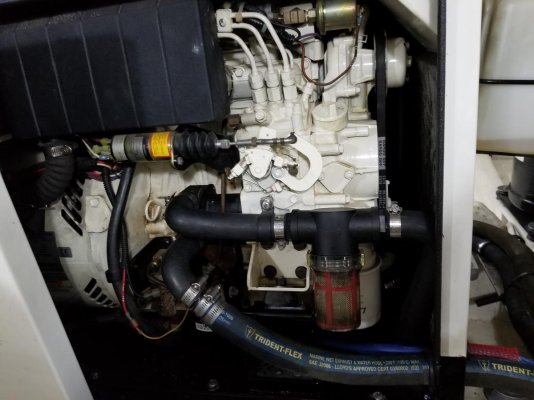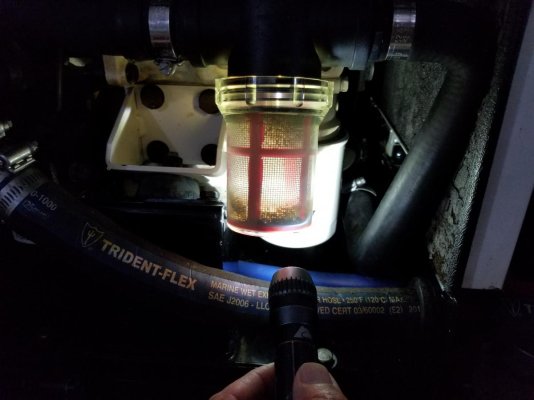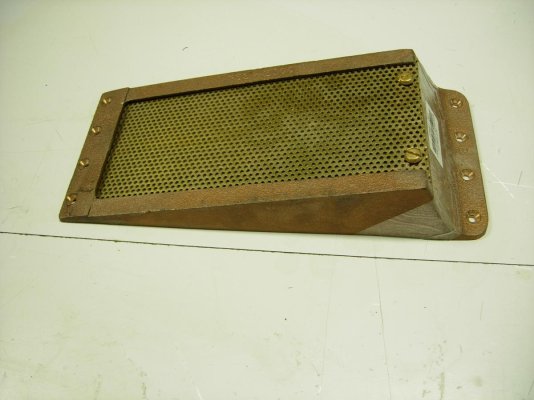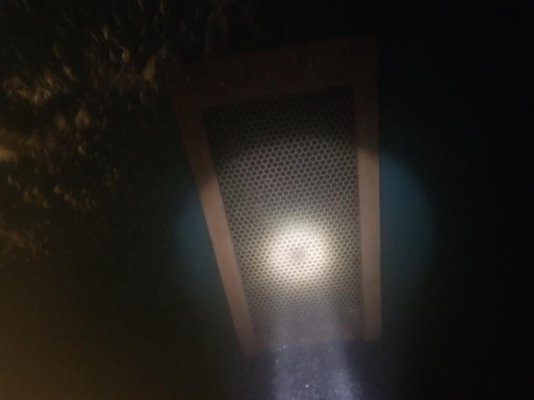You are using an out of date browser. It may not display this or other websites correctly.
You should upgrade or use an alternative browser.
You should upgrade or use an alternative browser.
Engine impeller change frequency
- Thread starter Insequent
- Start date
The friendliest place on the web for anyone who enjoys boating.
If you have answers, please help by responding to the unanswered posts.
If you have answers, please help by responding to the unanswered posts.
- Joined
- Oct 1, 2007
- Messages
- 7,331
- Location
- Texas
- Vessel Name
- Floatsome & Jetsome
- Vessel Make
- Meridian 411
True Baker, true.
But, disassembling the aftercooler (which really should be pressure tested when disassembled), or removing the hose and "fishing out" the small pieces through the opening, sounds like much more work than just opening a strainer and removing the bits. Now having the space to place a strainer between the raw water pump and the aftercooler can prove difficult, especially if on the Cummins 6BTA with an installed fuel cooler between the pump and aftercooler. I removed my fuel cooler and now there is probably room, so I am considering it, although so far, there has not been an impeller issue. Only takes once though.
Man I thought I typed out a reply to this...maybe I replied improperly on some other thread.
No disassembly required to find pieces near the aftercooler. The raw water goes straight into the bottom from the fuel cooler(or your bypass hose) and run into a dead end right there. They would be in the lower end cap of the cooler. Just pull the hose from the fuel cooler to the aftercooler and they would be right there.
- Joined
- Oct 6, 2007
- Messages
- 841
- Location
- Poulsbo, WA
- Vessel Name
- Dream Catcher
- Vessel Make
- Nordic Tug 37-065
Changed my impeller yesterday. I also have the Cummins 6BTA 330 hp and changed over to the SMX 1730 pump a few years ago. Nice pump, definitely better built compared to the Sherwood (stock one). The old impeller had 2 years of use, and almost 500 hours on it. On close examination, the old impeller looked "almost new".
During the winter, I don't use the boat. I store the engine with a mixture of freshwater and "salt away" in the raw water system. The local dock water is shut off to prevent freezing, so if I want to keep the saltwater out of my system, no running of the engine during the winter down time. So, I "bump" the starter every month to move the impeller to prevent it taking a set. This seems to be working??
I think I probably could go 3 years if I removed the pump cover annually to visually inspect the impeller condition. However, being somewhat conservative, I think I will do the annual inspection and stick to the 2 year interval.
Richard C., how long do you think (hours) before the pump might need a rebuild or are you going to wait for a visual signal (like a leak)?
Hi Tom,
I don't have a clue how long the SMX will last, but I sure am impressed with how long the impellers last. When I open up to change impellers I feel around inside, and take a peek at the cam. Silicone grease everywhere when installing new. 3,100 hours and so far seems perfect.
On my Volvo 44, the less robust Johnson pump lasted 4500 hours before replacement. I rebuilt once with new seals before that. It showed it needed that by leaking near the seals. Impellers sometimes did not last a summer (400 hours), even though I removed for the winter and installed a new one in the spring every year. Impeller cover plates lasted maybe 1200 hours before wear grooves got too big.
kapnd
Guru
- Joined
- Aug 31, 2013
- Messages
- 880
- Location
- usa
- Vessel Name
- #31
- Vessel Make
- ex-Navy MUB 50 fish/cruise
My Cummins SMX gets a new impeller annually, new seals every 3 years.
The spare I carry is new, not the one I took out last year.
I’d rather do it on a scheduled basis than as a surprise.
Mr Murphy says that if the impeller or seals fail, it will be at the worst possible time, so with a single engine, I just won’t risk that.
The spare I carry is new, not the one I took out last year.
I’d rather do it on a scheduled basis than as a surprise.
Mr Murphy says that if the impeller or seals fail, it will be at the worst possible time, so with a single engine, I just won’t risk that.
rslifkin
Guru
- Joined
- Aug 20, 2019
- Messages
- 7,593
- Location
- USA
- Vessel Name
- Hour Glass
- Vessel Make
- Chris Craft 381 Catalina
As a note on impeller failures and when they happen, it seems like impellers (engine or generator) almost always fail on startup. I've only seen a single failure once the system was already pumping, and that impeller was quite old when it failed. The only other times I've seen loss of raw water flow on a running engine, it's been due to sucking up trash that clogged the intake thru hull.
lady sue
Veteran Member
- Joined
- Mar 23, 2018
- Messages
- 31
- Location
- United States
- Vessel Name
- Lady Sue
- Vessel Make
- 34 Mainship I 1982 Perkins
Great discussion
Lady Sue, 1982 Mainship I, original Perkins, has been getting a new impeller annually since 1990.
Jim Ferry
Lady Sue, 1982 Mainship I, original Perkins, has been getting a new impeller annually since 1990.
Jim Ferry
Begorrah
Veteran Member
Every two years which is about 200 hours. They don't cost that much and it's a lot easier making the change at the dock.
Salish Nomad
Senior Member
- Joined
- Jan 13, 2017
- Messages
- 317
- Location
- Anacortes WA U.S.A.
- Vessel Name
- Salish Nomad
- Vessel Make
- American Tug 34
I've upgraded the original Sherwood seawater pump on our Cummins 6BTA 5.9 M3 to a Seaboard Marine SMX 1730 pump. Replaced the impeller every two years and 1600 hours. So far (two replacements) it has always looked OK. Thinking I might go to annually.
We did the same upgrade to the SMX., and cary the Sherwood as a spare. We are trying a Staycool impeller in the SMX pump. So far so good (400+hours)
Irish Rambler
Guru
- Joined
- Apr 29, 2014
- Messages
- 1,733
- Location
- FRANCE
- Vessel Name
- 'Snow Mouse.'
- Vessel Make
- BROOM FLYBRIDGE 42.
Ooops, I'm doing something wrong by the sound of things.
I have a OE Jabsco seawater pump fitted on my Perkins M90 and have never changed an impeller.
I did fit a 'Run Dry' kit which I count as wonderful but sadly the guy who made them in England suffered bad health and had to give it up.
I wish some guy interested in boats/engines and wanting a paying hobby, maybe small machine shop would buy the patents and start making them again as they're brilliant.
I have a OE Jabsco seawater pump fitted on my Perkins M90 and have never changed an impeller.
I did fit a 'Run Dry' kit which I count as wonderful but sadly the guy who made them in England suffered bad health and had to give it up.
I wish some guy interested in boats/engines and wanting a paying hobby, maybe small machine shop would buy the patents and start making them again as they're brilliant.
O C Diver
Guru
- Joined
- Dec 16, 2010
- Messages
- 12,878
- Location
- USA
- Vessel Name
- Slow Hand
- Vessel Make
- Cherubini Independence 45
I believe it is Ted (O C Diver) that added a strainer between his raw-water pump and heat exchanger. His set up is designed to catch broken pieces of impeller before migrating to the heat exchanger, etc. Ted?
I change my impellers annually. Shutting down my single engine could put me at great risk in some of the places I go. Impellers are another item in the overall cost of boating that cost not nothing. Here are some pics from the strainer on my generator. Easy to shine a light in it each morning when I check the oil.


Ted
catalinajack
Guru
Which is why twins are better than singles.
I change my impellers annually. Shutting down my single engine could put me at great risk in some of the places I go. Impellers are another item in the overall cost of boating that cost not nothing. Here are some pics from the strainer on my generator. Easy to shine a light in it each morning when I check the oil.
View attachment 101453
View attachment 101454
Ted
O C Diver
Guru
- Joined
- Dec 16, 2010
- Messages
- 12,878
- Location
- USA
- Vessel Name
- Slow Hand
- Vessel Make
- Cherubini Independence 45
Which is why twins are better than singles.
As someone here recently said and I paraphrase, "I only need one running engine and that's why I have two".
If you can't dock a single engine boat and you don't do preventative maintenance well, you should have two engines in a displacement hull boat.
Ted
rslifkin
Guru
- Joined
- Aug 20, 2019
- Messages
- 7,593
- Location
- USA
- Vessel Name
- Hour Glass
- Vessel Make
- Chris Craft 381 Catalina
As someone here recently said and I paraphrase, "I only need one running engine and that's why I have two".
If you can't dock a single engine boat and you don't do preventative maintenance well, you should have two engines in a displacement hull boat.
Ted
To me it depends on where you boat. I'm a strong believer in Murphy's law. If I'm mostly boating in places where if an issue crops up, I can sit or drop an anchor for a few minutes while I sort the issue out, I'm content with a single. If I'm regularly in tight or high traffic places, I'd rather have twins, as it gives the option of shutting one down and sorting out the issue either underway or in a few minutes when in a better spot.
Of course, no amount of systems redundancy is a replacement for doing proper maintenance. It doesn't matter if you have 1 or 5 of something, it's still good to know it'll all work when you want it to.
OldDan1943
Guru
- Joined
- Oct 2, 2017
- Messages
- 10,599
- Location
- USA
- Vessel Name
- Kinja
- Vessel Make
- American Tug 34 #116 2008
but ER is very hot.
O C Diver
Guru
- Joined
- Dec 16, 2010
- Messages
- 12,878
- Location
- USA
- Vessel Name
- Slow Hand
- Vessel Make
- Cherubini Independence 45
To me it depends on where you boat. I'm a strong believer in Murphy's law. If I'm mostly boating in places where if an issue crops up, I can sit or drop an anchor for a few minutes while I sort the issue out, I'm content with a single. If I'm regularly in tight or high traffic places, I'd rather have twins, as it gives the option of shutting one down and sorting out the issue either underway or in a few minutes when in a better spot.
Of course, no amount of systems redundancy is a replacement for doing proper maintenance. It doesn't matter if you have 1 or 5 of something, it's still good to know it'll all work when you want it to.
There are certainly cruising parameters that justify a twin engine or single and a wing engine. I'm not crossing an ocean with a single although it has been done. For most coastal and inland cruising, between a generally benign environment and the availability of tow boats, I find the exceptionally low risk acceptable, but then I'm OCD on PM.
Ted
OldDan1943
Guru
- Joined
- Oct 2, 2017
- Messages
- 10,599
- Location
- USA
- Vessel Name
- Kinja
- Vessel Make
- American Tug 34 #116 2008
Okay, I do believe we have flogged this subject enough.
Ya'l have fun.
Ya'l have fun.
rslifkin
Guru
- Joined
- Aug 20, 2019
- Messages
- 7,593
- Location
- USA
- Vessel Name
- Hour Glass
- Vessel Make
- Chris Craft 381 Catalina
There are certainly cruising parameters that justify a twin engine or single and a wing engine. I'm not crossing an ocean with a single although it has been done. For most coastal and inland cruising, between a generally benign environment and the availability of tow boats, I find the exceptionally low risk acceptable, but then I'm OCD on PM.
Ted
It's funny, I tend to go the other way. I'd be more ok with a single (and lots of spares and tools) when far away from anything, as a failure is generally less time-critical. If I need to shut it down right now and work on it for a few hours, no big deal (especially if there's a wing engine or a hydraulic get-home setup or something). But in a channel with a bunch of other boats, I appreciate the ability to just shut one down, retain reasonable maneuverability and then deal with the problem when safe.
FWIW, most engine shutdowns I've seen have not been maintenance related. I've seen a sudden overheat due to a stuck thermostat (no prior warning, cooling system was well maintained). Sudden loss of raw water flow due to plastic bag sucked into thru hull. Sudden loss of engine due to fuel pump failure with no prior symptoms. Or this summer's failure. Sheared teeth on a plate in the trans reduction planetary on the port side. No noises, no warning, just sudden loss of power output from the trans. Stuff like that. Some of those would have required a tow on a single, some wouldn't, but all required a shutdown to assess / resolve the issue.
High Wire
Guru
My last impeller was changed with 1108 engine hours. It was a new Jabsco impeller kit from my spares installed before we left for our East Coast trip in Mar 2018. The water flow was unchanged the whole trip. Inspection after removal Dec 2019 showed virtually no wear at all. No cracks or dryrot.
O C Diver
Guru
- Joined
- Dec 16, 2010
- Messages
- 12,878
- Location
- USA
- Vessel Name
- Slow Hand
- Vessel Make
- Cherubini Independence 45
FWIW, most engine shutdowns I've seen have not been maintenance related. I've seen a sudden overheat due to a stuck thermostat (no prior warning, cooling system was well maintained). Sudden loss of raw water flow due to plastic bag sucked into thru hull. Sudden loss of engine due to fuel pump failure with no prior symptoms. Or this summer's failure. Sheared teeth on a plate in the trans reduction planetary on the port side. No noises, no warning, just sudden loss of power output from the trans. Stuff like that. Some of those would have required a tow on a single, some wouldn't, but all required a shutdown to assess / resolve the issue.
First, remind me not to cruise near you. I can't afford that much bad luck so close to me.
Regarding the above, my OCD at refit addressed some of these issues.
I replace thermostats and radiator cap when charging coolant as they're relatively cheap. Other than infant mortality, life expectancy and peace of mind are greatly improved.
My raw water intake has an external perforated screen with 1/8" holes. It's oversized to eliminate vacuum from drawing things completely over it.
While I carry a spare, replacing the fuel lift pump will probably be a PM at 5,000 hours.
While I don't have a good PM on your transmission failure, my transmission and damper plate are rate for 450+ HP on my 135 HP engine. As I cruise with 40 HP, I'm counting on the percentage of load to reduce the risk.
Ted
rslifkin
Guru
- Joined
- Aug 20, 2019
- Messages
- 7,593
- Location
- USA
- Vessel Name
- Hour Glass
- Vessel Make
- Chris Craft 381 Catalina
First, remind me not to cruise near you. I can't afford that much bad luck so close to me.
Regarding the above, my OCD at refit addressed some of these issues.
Don't worry too much, most of those issues weren't on a boat in my care. And they were spread out over quite a number of years. As far as your point about making changes at refit, I absolutely agree that if I were doing the systems design on a boat, there would be some things I'd do differently, particularly around trans ratings (although I do have a good bit of headroom in the ratings on mine, so I'm not sure how much that really impacts the failure). As well as stuff like water intake design, ease of impeller changes, etc.
But on a boat where I'm not doing a heavy refit right now, there are certain things I'm stuck with. I do plan to change up my engine water intakes a bit in the next couple of years, however. The current scoops have an internal screen, which means they can't be un-clogged from inside the boat if necessary. I'd rather ditch the screen and be able to poke down through the thru hull to clear one. And I'd rather clean trash out of the strainer in the boat than from the outside where it's harder to get to.
O C Diver
Guru
- Joined
- Dec 16, 2010
- Messages
- 12,878
- Location
- USA
- Vessel Name
- Slow Hand
- Vessel Make
- Cherubini Independence 45
Don't worry too much, most of those issues weren't on a boat in my care. And they were spread out over quite a number of years. As far as your point about making changes at refit, I absolutely agree that if I were doing the systems design on a boat, there would be some things I'd do differently, particularly around trans ratings (although I do have a good bit of headroom in the ratings on mine, so I'm not sure how much that really impacts the failure). As well as stuff like water intake design, ease of impeller changes, etc.
But on a boat where I'm not doing a heavy refit right now, there are certain things I'm stuck with. I do plan to change up my engine water intakes a bit in the next couple of years, however. The current scoops have an internal screen, which means they can't be un-clogged from inside the boat if necessary. I'd rather ditch the screen and be able to poke down through the thru hull to clear one. And I'd rather clean trash out of the strainer in the boat than from the outside where it's harder to get to.
This is the scoop on my boat. The underwater picture shows my OCD with a different screen with slightly larger holes and nearly twice the total surface area of the hole openings.


Ted
Knot Salted
Senior Member
- Joined
- Mar 16, 2015
- Messages
- 322
- Location
- USA
- Vessel Name
- Knot Salted
- Vessel Make
- 1981 Californian 34 LRC
I pulled both Perkins 6.354 impellers three seasons ago. They were of black "rubber", and had a few small pieces missing - age unknown. No cooling issues. Replaced with the blue silicon material types. I will look at them this spring, but do not expect to need replacements (on hand) yet.
Ski in NC
Technical Guru
I've seen impellers last anywhere between 30sec and over ten years.
Really is a crapshoot.
Some pumps, the impellers seem to last forever. Others seem to be impeller eaters.
Jabsco's on Detroits, seen a bunch of 10yr old impellers that were still in good shape.
My Sherwood on Cummins, lucky to get two years.
My Northern Lights, maybe 3yrs. Some Onan gennies are imp eaters too, but not all.
If you have a new-to-you boat, my rec would be put a new impeller in right away. Then maybe a year later, pull it out and replace with new. If the one year old one looks just fine, then maybe go two years next. If vanes are starting to crack, stick with the year. If it looks great at two years, could go three, etc.
Be careful with keeping spares. These things age in the box. I changed one on a customer's boat and he said he had spares, no need to bring a new one. Box looked pretty aged and that impeller burned right up.
By all means keep spares, but don't let them sit too long.
Really is a crapshoot.
Some pumps, the impellers seem to last forever. Others seem to be impeller eaters.
Jabsco's on Detroits, seen a bunch of 10yr old impellers that were still in good shape.
My Sherwood on Cummins, lucky to get two years.
My Northern Lights, maybe 3yrs. Some Onan gennies are imp eaters too, but not all.
If you have a new-to-you boat, my rec would be put a new impeller in right away. Then maybe a year later, pull it out and replace with new. If the one year old one looks just fine, then maybe go two years next. If vanes are starting to crack, stick with the year. If it looks great at two years, could go three, etc.
Be careful with keeping spares. These things age in the box. I changed one on a customer's boat and he said he had spares, no need to bring a new one. Box looked pretty aged and that impeller burned right up.
By all means keep spares, but don't let them sit too long.
firehoser75
Guru
- Joined
- Feb 18, 2018
- Messages
- 1,706
- Location
- Canada
- Vessel Name
- former owner of "Pilitak"
- Vessel Make
- Nordic Tug 37
Good advice as usual Ski!!
jleonard
Guru
- Joined
- Jun 25, 2008
- Messages
- 5,066
My raw water intake has an external perforated screen with 1/8" holes. It's oversized to eliminate vacuum from drawing things completely over it.
And I thought I was the only one who did those kind of things. LOL
I approached it a different way and went up in size and added a "scoop" strainer to accomplish that. Haven't sucked a jellyfish in the generator filter since I made the change.
rslifkin
Guru
- Joined
- Aug 20, 2019
- Messages
- 7,593
- Location
- USA
- Vessel Name
- Hour Glass
- Vessel Make
- Chris Craft 381 Catalina
I like the strainers OC Diver has. I think they'd self-clear better than my current slotted scoops, although a big enough slotted scoop with no internal screen might be the best option as far as low risk of clogging and ease of cleaning from the inside.
Similar threads
- Replies
- 3
- Views
- 352
- Replies
- 22
- Views
- 2K
